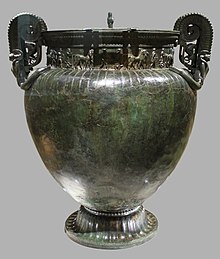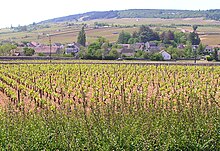Burgundy
The article's lead section may need to be rewritten. The reason given is: it does not summarise the article. (February 2017) |
Burgundy
Bourgogne | |
|---|---|
 | |
| Coordinates: 47°00′N 4°30′E / 47.000°N 4.500°E | |
| Country | |
| Dissolved | 1 January 2016 |
| Prefecture | Dijon |
| Departments | 4
|
| Government | |
| • NUTS Region | FR2 |
| Website | www.xn--rgion-bourgogne-bnb.fr (archive) |
Burgundy (
Upon the 9th-century partitions of the
The Burgundian State,
The extinction of the dynasty led to the absorption of the duchy itself into the French crown lands by King Louis XI, while the bulk of the Burgundian possessions in the Low Countries passed to Duke Charles the Bold's daughter, Mary, and her Habsburg descendants. Thus the partition of the Burgundian heritage marked the beginning of the centuries-long French–Habsburg rivalry and played a pivotal role in European politics long after Burgundy had lost its role as an independent political identity.
Etymology
It is named for the
Since the inception of the French departmental system in 1790, Burgundy has referred to the geographic area comprising the four departments of Côte-d'Or, Saône-et-Loire, Yonne, and Nièvre.[7]
History
This section needs additional citations for verification. (August 2022) |


The first recorded inhabitants of the area that was to become Burgundy were various tribes of
During the 4th century, the Burgundians, a Germanic people who may have originated on the Baltic island of Bornholm, settled in the western Alps. They founded the Kingdom of the Burgundians, which was conquered in the 6th century by another Germanic tribe, the Franks.[9]

Under Frankish dominion, the Kingdom of Burgundy continued for several centuries.
Later, the region was divided between the
Burgundy's modern existence is rooted in the dissolution of the
During the
During the Hundred Years' War, King John II of France gave the duchy to his youngest son, Philip the Bold. The duchy soon became a major rival to the crown. The court in Dijon outshone the French court both economically and culturally. Phillip the Bold's grandson Philip the Good acquired Namur, Hainaut, Brabant, and Holland in modern Belgium and the Netherlands. In 1477, at the battle of Nancy during the Burgundian Wars, the last duke Charles the Bold was killed in battle, and the Duchy itself was annexed by France and became a province. However, the northern part of the empire was taken by the Austrian Habsburgs.[12]
With the French Revolution in the end of the 18th century, the administrative units of the provinces disappeared, but were reconstituted as regions during the Fifth Republic in the 1970s. The modern-day administrative region comprises most of the former duchy.
In 2016, Burgundy and the historical region of Franche-Comté merged for administrative purposes into the new region of Bourgogne-Franche-Comté.[13]
Geography

The region of Burgundy is both larger than the old
- Burgundy: Côte-d'Or, Saône-et-Loire, and southern half of Yonne. This corresponds to the old duchy of Burgundy (later called province of Burgundy). However, the old county of Burgundy (later called province of Franche-Comté) is not included inside the Burgundy region, but it makes up the Franche-Comté region. Also, a small part of the duchy of Burgundy (province of Burgundy) is now inside the Champagne-Ardenne region.
- Nivernais: now the department of Nièvre.
- the northern half of Yonne is a territory that was not part of Burgundy (at least not since the 11th century), and was a frontier between Champagne, Île-de-France, and Orléanais, being part of each of these provinces at different times in history.
Major communities

Climate
The climate of this region is essentially oceanic (Cfb in
Politics
The
Culture



Burgundy is one of France's main wine-producing areas. It is well known for both its red and white wines, mostly made from
With regard to cuisine, the region is famous for Dijon mustard, Charolais beef, Bresse chicken, the Burgundian dishes coq au vin and beef bourguignon, and époisses cheese.[15]
Tourist sites of Burgundy include the Rock of Solutré, the Hospices de Beaune, the Ducal Palace in Dijon, and many Renaissance and mediaeval châteaus, castles, churches and abbeys.[16]
Earlier, the southeastern part of Burgundy was heavily industrial, with coal mines near Montceau-les-Mines and iron foundries and crystal works in Le Creusot. These industries declined in the second half of the twentieth century.
The local dialect is known as
References
- ^ "EU regions by GDP, Eurostat". Retrieved 18 September 2023.
- S2CID 162228105.
- OCLC 913446839.
- ISBN 978-2-262-02360-7.
- ISSN 2102-7188.
- ^ Poupardin, René, Chisholm, Hugh, ed. (1911). . Encyclopædia Britannica (11th ed.). Cambridge University Press.
- ISBN 9782851570031. Retrieved 23 May 2020.
- ^ "Battle of Alesia | Facts, Summary, & Combatants". Encyclopædia Britannica. Retrieved 9 September 2020.
- ^ S, Alen (16 February 2017). "Kingdom of the Burgundy (406-534)". Short history website. Retrieved 25 November 2020.
- ^ "Burgundy". Paris Digest. 2018. Retrieved 10 August 2018.
- ^ "Cluny, The second Rome". Interkultur Paris. 21 March 2020. Retrieved 25 November 2020.
- ^ "The Duchy of Burgundy, Medieval Powerhouse | eHISTORY". ehistory.osu.edu. Retrieved 25 November 2020.
- ^ "LOI n° 2015-29 du 16 janvier 2015 relative à la délimitation des régions, aux élections régionales et départementales et modifiant le calendrier électoral". Legifrance (in French). Secrétariat général du Gouvernement. Retrieved 20 May 2020.
- ^ "Bourgogne". 15 January 2016.
- ^ "Visit Burgundy, a Land of Adventure". us.france.fr.
- ^ "Visit Burgundy, a Land of Adventure". us.france.fr.
- ^ "Bourguignon-Morvandiau". Diary of a Winebuyer. 26 April 2016.
- ^ "4th Workship on Sound Change: Accepted Abstracts" (PDF). University of Edinburgh. 2017. Retrieved 19 July 2022.
- ISBN 9789027218483– via Google Books.
Further reading
- Allen, Percy (1912). Burgundy - The Splendid Duchy: Stories and Sketches in South Burgundy. London: F. Griffiths.
- Cope, Christopher (1986). Phoenix Frustrated: The Lost Kingdom of Burgundy. London: Constable.
- Dunlop, Ian (1990). Burgundy. London: Hamish Hamilton.
- Gunn, Peter (1976). Burgundy: Landscape with Figures. London: Victor Gollancz.
- Gwynn, Stephen (1930). Burgundy; with chapters on the Jura and Savoy. London: George G. Harrap & Co.
- Hatch, Evelyn M. (1927). Burgundy. Past and Present. London: Methuen.
- Lands, Neil (1977). History, People and Places in Burgundy. Spurbooks. History, People and Places series.
- Lecomte, Bernard; Thouart, Jean-Louis (2004). Burgundy, What a Story! (de Bourogne ed.). Editons de Bourgogne. ISBN 978-2-902650-02-6.
- ISBN 978-0-141-04886-4.
- Speaight, Robert (1975). The Companion Guide to Burgundy. London: Collins. revised and expanded by Francis Pagan, 1990 & 1996.
- Turner, Anthony; Brown, Christopher (1977). Burgundy. Batsford.
- Van Loo, Bart (2021). The Burgundians: A Vanished Empire. Head of Zeus. ISBN 978-1-789543-43-8.
- Loi n° 2015-29 du 16 janvier 2015 relative à la délimitation des régions, aux élections régionales et départementales et modifiant le calendrier électoral (in French)
- . Retrieved 4 March 2014.
External links
 Burgundy travel guide from Wikivoyage
Burgundy travel guide from Wikivoyage The dictionary definition of burgundy at Wiktionary
The dictionary definition of burgundy at Wiktionary Media related to Bourgogne at Wikimedia Commons
Media related to Bourgogne at Wikimedia Commons- (in English) Burgundy : history in the open air—Official French website
- (in French) Burgundy statistics on INSEEwebsite
- (in French) Regional Council website
- (in English) Short guide to Burgundy with main tourist attractions
- (in English) Burgundy at Curlie
- . Catholic Encyclopedia. 1913.
- . . 1914.



